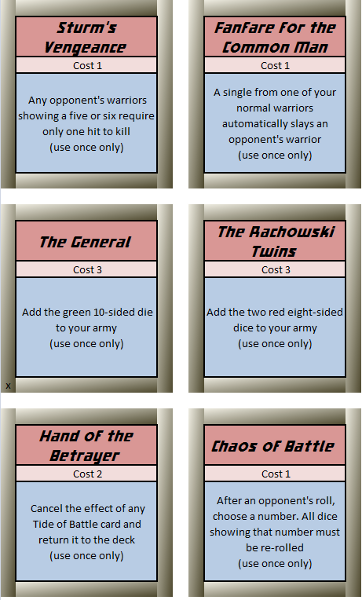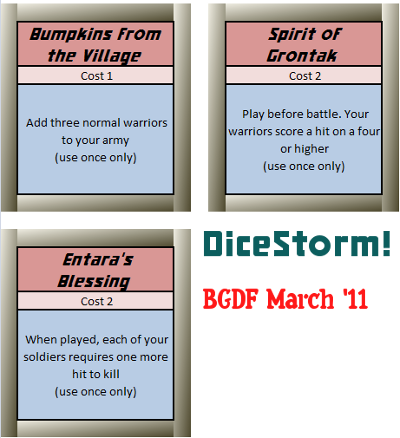Dicestorm
(c) 2011 by Dave Dobson / Plankton Games
2-4 players
2-4 players
Introduction
In the olden days, the Ur-gan clans of the Stonetop Mountains vied with each other under a strict code of mortal combat. To the losers, a decade of defeat, shame, and self-pity. To the winners, ten years of dominion over all the other clans.
You lead one of these clans in a battle to the death! Your warriors are represented by dice - each die is a warrior. When you are out of dice, your clan has lost, and you are out of the game. Will you fail, and lie unsung in a coward's grave, or will you roll to victory? (Get it? Roll? Get it?)
Components
- 30 white six-sided dice
- 1 black six-sided die
- 2 red eight-sided dice
- 1 green 10-sided die
- 4 Restoration mini-cards
- 14 Tide of Battle mini-cards
Object
Be the last player with surviving armies in the game
Setup
Each player gets a set of normal warriors (white six-sided dice). The number of starting dice depends on the number of players as follows:
- 2 players - 15 dice each
- 3 players - 10 dice each
- 4 players - 7 dice each
Each player also gets one Restoration card. Shuffle the Tide of Battle cards and place them face down nearby. Roll to see who goes first.
Game Play
Game play consists of two phases, the battle phase and the draw phase
Battle Phase
On each of your turns, you will battle with the opponent to your right. To conduct a battle, you and your opponent each roll all your warriors (your dice). Battles are resolved from the die rolls according to these rules:
- Each roll of five or higher counts as a hit
- The number showing on each die is the number of hits needed to defeat and remove that die
- The player dealing hits may decide which of the opponent's dice the hits affect
For example:
- Gollum has six dice and rolls: 6 5 4 4 2 1
- Frodo has seven dice and rolls: 6 6 5 3 2 1 1
Gollum has scored two hits, and he may either take out Frodo's two dice showing 1's or Frodo's one die showing a 2. Normally, it would be better to take out two dice rather than one, but if the die showing 2 is a special die, Gollum might want to get rid of that one. Frodo scores three hits and would probably use them to take out Gollum's two dice showing 2 and 1.
Draw Phase
After the battle is resolved, the player draws one card from the Tide of Battle deck. The player may choose to pay the cost shown on the card (the cost is paid in dice), or he may pass it to the right. The next player has the same choice - pay or pass. If the card makes it back around to the original location, the cost is reduced by one and the process repeats. Eventually the card will be bought, or the cost of the card will drop to zero, at which point it may be taken for free.
Losing
If you ever lose all of your dice, you are out of the game immediately, even if you could add more dice by playing a card.
Cards
There are two types of cards - Restoration cards and Tide of Battle cards. Restoration cards bring a player's force back up to its starting total. Tide of Battle cards can have many different effects. The following rules apply to these cards:
- Some cards have permanent effects; others can be played once only and are then discarded.
- Some cards are played at specific times in a battle or during a player's turn. Other cards can be played at any time as long as the player still has dice.
- Some cards call for additional dice to be added to a player's army. If those dice are not available when the card is played, they are not added or owed - they are lost. Partial adding is allowed (e.g. if a player is instructed to add five and three are available, he or she gets the three dice).
- If a player is ever out of warriors, he or she has lost and can play no cards, even if they would restore warriors to the player's army.
- Tide of Battle cards that are used are discarded. When all of these cards are used, shuffle the discards to restore the Tides of Battle pile.
- Restoration cards are never re-used once played.
Tide of Battle Cards
Explanations of the Tide of Battle cards are below.


















No comments:
Post a Comment